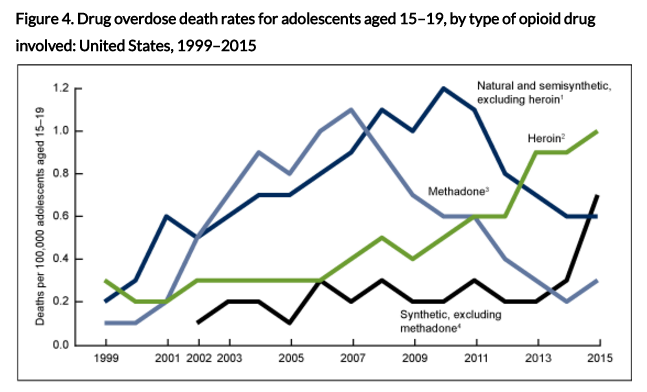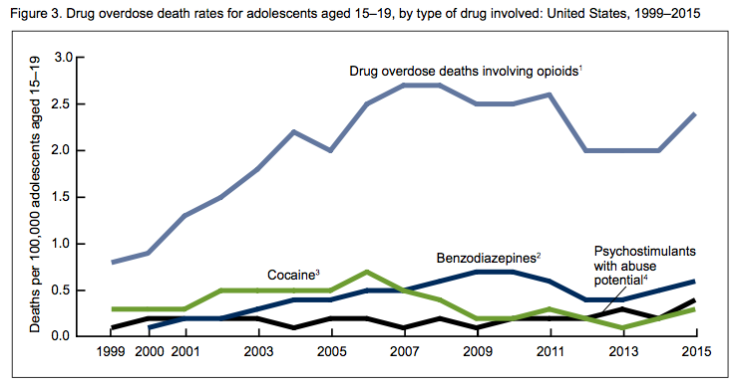CDC: Teen Drug Overdose Death Rates Doubled Between 1999 And 2015

The number of drug overdose deaths among teens ages 15 to 19 more than doubled since 1999 -- and opioid drugs including heroin are to blame, according to new figures from the Centers for Disease Control and Prevention.
Between 1999 and 2007, the drug overdose death rate for the age group more than doubled, but then fell by 26 percent between 2007-2014. However, the number of deaths increased again in 2015, the report said.
The numbers come as President Donald Trump declared the opioid crisis a national emergency last week. Approximately 90 people in the U.S. die from an opioid-related overdose every day, according to the CDC.
Opioid and Heroin Deaths
The death rate of overdose deaths related to opioids among teens in the U.S. tripled from 1999 to 2007. In 2015 alone, there were a total of 772 deaths due to drug overdoses among adolescents. That year, heroin was the biggest contributor when looking at opioid-related deaths among teens.
Heroin deaths among those ages 15-19 spiked during the 1999-2015 timeframe. In 2015, the death rate had already tripled. The number of fatalities related to natural and semisynthetic opioids, not counting heroin, jumped from 1999 to 2010 and then decreased in 2014-2015, the CDC data show. The number of deaths involving methadone was approximately 10 times higher in 2007 than it was in 1999. Meanwhile, the death rate involving synthetic opioids, like fentanyl and tramadol, increased between 2002 and 2015.
The CDC broke down the death rates by type of opioid drug used:

“The opioid crisis is at a historic high, and it is likely that drug overdoses among teens will continue to rise as well”, Sebastian Seiguer, CEO of Emocha, told International Business Times. Emocha teamed up with Johns Hopkins and the CDC and developed an app to make sure people take their medications and tries to prevent opioid addiction.
“Opioid addiction at such a young age is devastating,” said Seiguer, “schools urgently need mechanisms to identify at-risk students and direct them to professional treatment help and resources.”
There are programs like D.A.R.E. that educate young people about the dangers of drugs, however it might not be as helpful, according to Seiguer.
“The results of over 30 studies have shown that D.A.R.E. has not prevented drug use, short- or long-term, and students who participated in the program were indistinguishable from those who did not,” said Seiguer. “School programming may help some, but many people with opioid addiction develop disorders following a legal prescription of prescription pain medication.”
He added that it’s important to educate school administrators that they should “treat drug use as a health risk rather than only as a disciplinary issue.”
The CDC numbers come as South Carolina takes legal action against opioid manufacturer Purdue Pharma, alleging the company helped fuel the opioid crisis in the state. However, Seiguer believes that’s not the best approach in solving the opioid epidemic. Other states have also sued pharmaceutical companies.
“State resources are better spent expanding medicated assisted treatment and providing infrastructure and systems which treats citizens with empathy and compassion to help them beat addiction,” said Seiguer. “Jailing minor offenders, suing manufacturers, and other legal remedies are sideshows.”
To curb the opioid epidemic, states should monitor prescriptions with state-run databases that track the prescribing of controlled prescription drugs, like opioids, to patients.
“This information could help physicians and prescribers identify patients, especially teens, at risk of developing an opioid use disorder,” said Seiguer. “The system can also identify over-prescribers. Together with increased funding for counseling and treatment options, this would be one way officials can reduce [opioid use disorders] among teenagers.
Overall Drug Overdose Deaths Among Teens
Although opioids were to blame for most overdose deaths, fatalities involving other drugs also increased. The death rate involving cocaine increased between 1999 and 2006, while fatalities involving benzodiazepines jumped in 2000-2009. The overdose death rate for both drugs also saw a decrease and stabilization a few years later and began increasing again in 2015.

Male Teens Saw Higher Drug Overdose Death Rate
Throughout 1999 to 2015, drug overdose death rate for male teens were higher than female adolescents. The death rates among male teens almost tripled between 1999 and 2007.
Both men and women saw increases between 1999 and the mid 2000s, but only male teens saw the death rate decrease between 2007 and 2014. Female teens saw death rates nearly double between 1999 to 2004. While the overdose death rate among girls remained stable between 2004 to 2013, female teens saw the number of fatalities increase by 35 percent between 2013 and 2015.
This graph by the CDC shows the how the drug overdose death rate increased among male and female teens between 1999 to 2015:

In 2015, the majority of overdose death rates among male and female teens were unintentional, however, young girls were more than twice as likely to commit suicide through overdosing, the CDC said. More than 20 percent of drug overdose fatalities among female teens were suicide, compared to 8.7 percent for male adolescents.
© Copyright IBTimes 2025. All rights reserved.



















